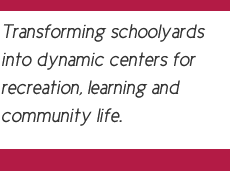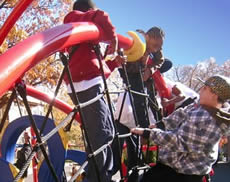News
| Contact Information Angela Nardozzi |
| Denver-based Schoolyard Group Visits Boston Schoolyard Initiative |
| Boston, MA (April 20, 2011) - Over a breakfast of bagels and coffee, Boston Schoolyard Initiative and Learning Landscapes, a Denver-based schoolyard group much like the Boston Schoolyard Initiative, exchanged notes in BSI’s office in Boston. Like BSI, Learning Landscapes has transformed around 80 schoolyards from asphalt jungles to community recreation spaces. The Denver and Boston schoolyard groups found a variety of items in common: both partner closely with their respective public school systems to deliver their renovation programs and design the schoolyards so they are both school and community recreation resources. Differences include that the Denver program is housed at the University of Colorado Denver College of Architecture and Planning and is primarily funded through a bond initiative, and BSI is a public-private partnership, funded by the City of Boston and private funders. BSI has a more strongly developed education program, while Learning Landscapes has deep research on use of schoolyards for increasing active play. Concerned with the rapid increase in childhood obesity, the Learning Landscapes team has found significant correlations between changes in a child’s outdoor environment and their physical activity levels. In a study conducted in 2005, nine schools in the Denver area were picked for the study and divided into three groups. Each group consisted of one school that had a Learning Landscapes schoolyard recently built, one with an established Learning Landscapes schoolyard (two years or longer), and one control school that had neither. Their results illustrated that between the control schools and the schools with Learning Landscapes schoolyards, Learning Landscape schoolyards showed an increase in the volume of children using the spaces as well as the increase in activity per child. Children with established schoolyards had slight decreases in activity levels compared to recently built schoolyards. Overall, the established Learning Landscape schoolyards continue to trump the control schoolyards in activity levels, which Learning Landscapes attributes to the design of the outdoor area. Gender analysis done on the different spaces demonstrated that boys showed an increase in volume and activity in all the spaces, while girls gravitated towards spaces with soft-surfaces and fall zones. By providing a variety of areas that appeal to children based on gender, overall activity levels have risen in Denver Public School children with Learning Landscape schoolyards. While BSI has benefited from their endeavors in research and gender studies in the schoolyard, Denver Learning Landscapes is particularly interested in BSI’s Science in the Schoolyard and Outdoor Writers Workshop programs. The two organizations continue to work together to better their programs and increase information flow between the two cities. For more information about Learning Landscapes, visit their website at www.learninglandscapes.org. |




